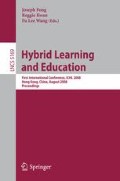Abstract
The purpose of this article is to develop a design theory of blended learning curriculum in ways of establishing a model for designing such a curriculum and a model for designing an activity in a blended learning curriculum as well as demonstrating how these models can be utilized in a curriculum design. It first attempts to define what the essence of blended learning is by drawing on definitions of previous studies. Then, it goes on to identify the characteristics and rationales of blended learning. Finally, it exemplifies the devised BLC activity model, which is supported by the BLC design model and the BLC process model.
Access this chapter
Tax calculation will be finalised at checkout
Purchases are for personal use only
Preview
Unable to display preview. Download preview PDF.
References
Bricheno, P., Higgison, C., Weedon, E.: The Impact of Networked Learning on Education Institutions. UHI Millenium Institute & Bradford University—INLEI, Bradford (2004), http://www.sfeuprojects.org.uk/inlei/
Carman, J.M.: Blended Learning Design: Five Key Ingredients (2005), http://www.agilantlearning.com/pdf/Blended%20Learning%20Design.pdf
Clark, D.R.: Blended Learning (2007), http://www.nwlink.com/~Donclark/hrd/elearning/blended.html
Clarke, S., Lindsay, K., McKenna, C., New, S.: INQUIRE: a case study in evaluating the potential of online MCQ tests in a discursive subject. ALT-J, Research in Learning Technology 12(3), 249–260 (2004)
Garrison, D.R., Kanuka, H.: Blended learning: Uncovering Its Transformative Potential in Higher Education. Internet and Higher Education 7, 95–105 (2004)
He, K.K.: The New Developments in the Theory of Educational Technology from the Perspective of Blended Learning (I). E-Education Research 2004(3), 1–6 (2004)
Huang, R.H., Zhou, Y.L., Wang, Y.: Blended Learning: Theory into Practice. Higher Education Press, Beijing (2006)
JISC: Study of Environments to Support E-learning in UK Further and Higher Education: A Supporting Study for the Joint Information Systems Committee. Joint Information Systems Committee (JISC): Bristol (2005), http://www.jisc.ac.uk/uploaded_documents/e-learning_survey_2005.pdf
Merrill, M.D.: First Principles of Instruction. ETR & D 50(3), 43–59 (2002)
Molesworth, M.: Collaboration, Reflection and Selective Neglect: Campus-Based Marketing Students’ Experiences of Using a Virtual Learning Environment. Innovations in Education and Teaching International 41(1), 79–92 (2004)
Sharpe, R. (n.d.).: Why blend? Rationales for blended e-learning in undergraduate education. The Higher Education Academy, http://www.heacademy.ac.uk/assets/York/documents/ourwork/research/literature_reviews/blended_elearning_why_blend.pdf
Sharpe, R., Benfield, G., Roberts, G., Francis, R.: The Undergraduate Experience of Blended E-Learning: A Review of UK Literature and Practice. The Higher Education Academy (2006), http://www.heacademy.ac.uk/assets/York/documents/ourwork/research/literature_reviews/blended_elearning_full_review.pdf
Shaw, S., Igneri, N.: Effectively implementing a blended learning approach: maximizing advantages and eliminating disadvantages (2006), http://adlcommunity.net/file.php/11/Documents/Eedo_Knowledgeware_whitepaper_Blended_Learning_AMA.pdf
Singh, H., Reed, C.: A White Paper: Achieving Success with Blended Learning. Centra Software (2001), http://www.centra.com/download/whitepapers/blendedlearning.pdf
Ward, G.: Flexible delivery: A report on an evaluation of the use of the virtual learning environment in higher education across Scotland. The Quality Assurance Agency for Higher Education (2006), http://www.enhancementthemes.ac.uk/documents/flexibleDelivery/Flexible_delivery_QAA_128.pdf
Whitelock, D., Jelfs, A.: Editorial. Journal of Educational Media 28(2–3), 99–100 (2003)
Wood, E.J.: Review: Problem-based learning. Acta Biochimica Polonica Quarterly 51(2), XXI–XXVI (2004), http://www.actabp.pl/pdf/2_2004/XXI.pdf
Author information
Authors and Affiliations
Editor information
Rights and permissions
Copyright information
© 2008 Springer-Verlag Berlin Heidelberg
About this paper
Cite this paper
Huang, R., Ma, D., Zhang, H. (2008). Towards a Design Theory of Blended Learning Curriculum. In: Fong, J., Kwan, R., Wang, F.L. (eds) Hybrid Learning and Education. ICHL 2008. Lecture Notes in Computer Science, vol 5169. Springer, Berlin, Heidelberg. https://doi.org/10.1007/978-3-540-85170-7_6
Download citation
DOI: https://doi.org/10.1007/978-3-540-85170-7_6
Publisher Name: Springer, Berlin, Heidelberg
Print ISBN: 978-3-540-85169-1
Online ISBN: 978-3-540-85170-7
eBook Packages: Computer ScienceComputer Science (R0)

